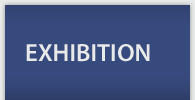

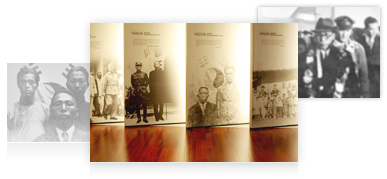
Activities with KPG (1939 ∼ 1945)
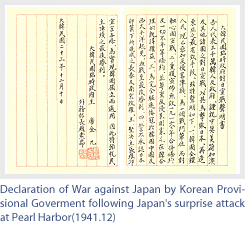 In September 1940 Kim Koo settled in Chongqing, China, and systemized the tripartite structure of the KPG party, administrative system, and independence army. By converging these groups, he formed the Korean Independence Party in May and the Korean Independence Army(KIA) in September 1940. In October of the same year, he introduced a premier system in the KPG that strengthened the leadership and accelerated independence activities. After the liberation of Korea, he made a blueprint to rebuild a unified nation in November and declared war on Japan in December in line with China and Great Britain. For the joint advancing troop operations into Korea, he conducted a joint military drill with the KIA and the US OSS(Office of Strategic Service). He planned to enter the Korean peninsula via Jeju-do Island.
In September 1940 Kim Koo settled in Chongqing, China, and systemized the tripartite structure of the KPG party, administrative system, and independence army. By converging these groups, he formed the Korean Independence Party in May and the Korean Independence Army(KIA) in September 1940. In October of the same year, he introduced a premier system in the KPG that strengthened the leadership and accelerated independence activities. After the liberation of Korea, he made a blueprint to rebuild a unified nation in November and declared war on Japan in December in line with China and Great Britain. For the joint advancing troop operations into Korea, he conducted a joint military drill with the KIA and the US OSS(Office of Strategic Service). He planned to enter the Korean peninsula via Jeju-do Island.
Right-Left Coalition
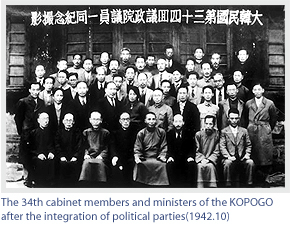 In 1939 Kim Koo and Kim Won-bong agreed to converge the powers of right-wing and left-wing independence activists and publicized their joint declaration : "To my Comrades and the Korean People". His continuous solicitation of leftist parties resulted in the Korean People's Liberation League led by Kim Seong-suk, which vindicated the KPG party in 1941. This was followed by the incorporation of the Korean Voluntary Army into the 1st Division of Korean Independence Army in 1942. In October of the same year, major pro-left figures participated in the KPG's 34th National Assembly session. In 1944 Kim Koo successfully steered the right and left powers towards political unification under the KPG.
In 1939 Kim Koo and Kim Won-bong agreed to converge the powers of right-wing and left-wing independence activists and publicized their joint declaration : "To my Comrades and the Korean People". His continuous solicitation of leftist parties resulted in the Korean People's Liberation League led by Kim Seong-suk, which vindicated the KPG party in 1941. This was followed by the incorporation of the Korean Voluntary Army into the 1st Division of Korean Independence Army in 1942. In October of the same year, major pro-left figures participated in the KPG's 34th National Assembly session. In 1944 Kim Koo successfully steered the right and left powers towards political unification under the KPG.
Efforts for Self-Reliant National Independence
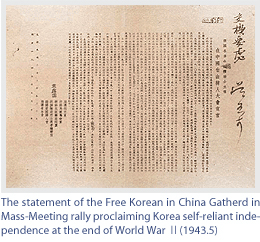 Efforts for Self-Reliant National Independence When the trusteeship of Korea was discussed in early 1943, Kim Koo held an anti-trusteeship rally of Korean residences in China, proclaiming to a worldwide audience that Korea should be an independent country of free people. In July 1943, Kim Koo and influential figures of the KPG met with Jiang Jieshi, Generalissimo of the Chinese Nationalist government, and he appealed to the Generalissimo to support Korean independence at the Cairo Conference. However, when the Cairo Declaration added the proviso "in due course" that implied postponing Korea's independence until the time was deemed ripe, Kim Koo advocated Korea's immediate independence.
Efforts for Self-Reliant National Independence When the trusteeship of Korea was discussed in early 1943, Kim Koo held an anti-trusteeship rally of Korean residences in China, proclaiming to a worldwide audience that Korea should be an independent country of free people. In July 1943, Kim Koo and influential figures of the KPG met with Jiang Jieshi, Generalissimo of the Chinese Nationalist government, and he appealed to the Generalissimo to support Korean independence at the Cairo Conference. However, when the Cairo Declaration added the proviso "in due course" that implied postponing Korea's independence until the time was deemed ripe, Kim Koo advocated Korea's immediate independence.
Korea Independence Army
 In the 1930's Kim Koo set up a special Korean course at the Rouyang Military Academy in China to train Korean officers. From the time when the KPG settled down in Chongqing, China, he worked to raise an army. On September 17, 1940, the inaugural ceremony for the establishment of the KIA was held at Garunbin Hall, Chongqing. The KIA fought against the Japanese, joining forces with Chinese, British, and American troops. In 1945, the KIA mapped out operations with the US OSS to advance troops into Korea, but the operations were not necessary as the Japanese surrendered soon after.
In the 1930's Kim Koo set up a special Korean course at the Rouyang Military Academy in China to train Korean officers. From the time when the KPG settled down in Chongqing, China, he worked to raise an army. On September 17, 1940, the inaugural ceremony for the establishment of the KIA was held at Garunbin Hall, Chongqing. The KIA fought against the Japanese, joining forces with Chinese, British, and American troops. In 1945, the KIA mapped out operations with the US OSS to advance troops into Korea, but the operations were not necessary as the Japanese surrendered soon after.
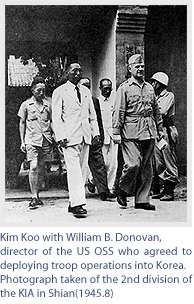
Return to Korea
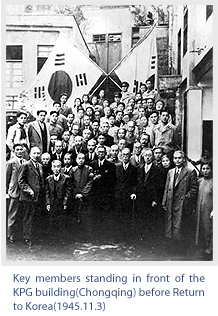 When Kim Koo and the KPG returned to Korea from Chongqing via Shanghai in November 1945, the Chinese nationalist government and the communist party gave a hearty farewell ceremony. After an absence of 27 years, Kim Koo set foot again in Korea when he arrived at Gimpo Airport on November 23, 1945. The complete return of all other KPG organizations to Korea was accomplished on December 2, and the Korean people held a welcome-home celebration at Dongdaemun Stadium on December 19.
When Kim Koo and the KPG returned to Korea from Chongqing via Shanghai in November 1945, the Chinese nationalist government and the communist party gave a hearty farewell ceremony. After an absence of 27 years, Kim Koo set foot again in Korea when he arrived at Gimpo Airport on November 23, 1945. The complete return of all other KPG organizations to Korea was accomplished on December 2, and the Korean people held a welcome-home celebration at Dongdaemun Stadium on December 19.








